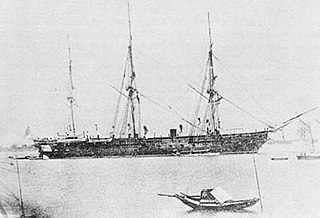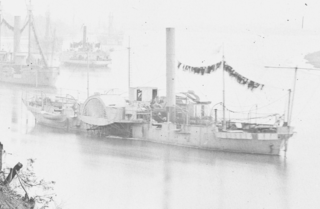
USS Brooklyn was a sloop-of-war authorized by the U.S. Congress and commissioned in 1859. Brooklyn was active in Caribbean operations until the start of the American Civil War at which time she became an active participant in the Union blockade of the Confederate States of America.
USS A. Houghton – a 326 ton bark – was purchased during the beginning of the American Civil War by the Union Navy.

The first USS Colorado, a 3,400-long-ton (3,500 t), three-masted steam screw frigate, was launched on 19 June 1856, by the Norfolk Navy Yard. Named after the Colorado River, she was sponsored by Ms. N. S. Dornin, and commissioned on 13 March 1858, with Captain W. H. Gardner, in command. She was the fifth of the "Franklin-class" frigates, which were all named after US rivers, except for Franklin.

USS Hartford, a sloop-of-war steamer, was the first ship of the United States Navy named for Hartford, the capital of Connecticut. Hartford served in several prominent campaigns in the American Civil War as the flagship of David G. Farragut, most notably the Battle of Mobile Bay in 1864. She survived until 1956, when she sank awaiting restoration at Norfolk, Virginia.

The first USS Miami was a side-wheel steamer, double-ender gunboat in the United States Navy during the American Civil War.

USS Richmond was a wooden steam sloop in the United States Navy during the American Civil War.
USS Henry Janes was a mortar schooner acquired by the United States Navy during the American Civil War. She was used as a gunboat and assigned to the blockade of ports of the Confederate States of America.

USS Owasco was a Unadilla-class gunboat built for the Union Navy during the American Civil War. She was named for Owasco Lake.
The second United States Navy vessel to bear the name, USS Sachem was a screw steamer built in 1844 at New York City, where the U.S. Navy purchased her on 20 September 1861.
USS Horace Beals was a barkentine acquired by the Union Navy during the American Civil War. She was placed into service as a cargo ship assigned to support the fleet blockading the ports of the Confederate States of America. However, at times, Horace Beals was assigned extra tasks, such as that of a hospital ship as well as an ammunition ship.
USS Sarah Bruen was a wooden schooner acquired by the United States Navy during the beginning of the American Civil War.

USS Winona was a Unadilla-class gunboat built for service with the Union Navy during the American Civil War. Winona was heavily armed, with large guns for duels at sea, and 24-pounder howitzers for shore bombardment. Winona saw significant action in the Gulf of Mexico and in the waterways of the Mississippi River and was fortunate to return home safely after the war for decommissioning.

USS Racer was a schooner acquired by the Union Navy during the American Civil War. She was used for various purposes, but, especially for bombardment because of her large 13-inch mortar that could fire up and over tall riverbanks.
USS John Griffith was a mortar schooner acquired by the Union Navy during the American Civil War. She was used for various purposes, but especially for bombardment because of her large 13-inch mortar and 12-pounder howitzers that could fire up and over tall defensive riverbanks.

USS Maria J. Carlton was a schooner acquired by the United States Navy on October 15, 1861, during the American Civil War. Built before the war, the vessel was converted into a mortar schooner by the Navy. She was then transferred to the mouth of the Mississippi River in early 1862, as part of a force tasked with neutralizing Confederate forts guarding New Orleans, Louisiana. Maria J. Carlton participated in the Battle of Forts Jackson and St. Philip on April 18, but, the battle continuing, was sunk the next day by a shot from Fort Jackson. She was the only Union warship sunk solely by artillery fire from Confederate forts on the Mississippi River during the war.
USS Matthew Vassar was a schooner purchased by the Union Navy during the American Civil War. She was used by the Union Navy primarily as a mortar gunboat, but also as a gunboat stationed off Confederate ports to prevent their trading with foreign countries.
USS George Mangham was a schooner acquired by the Union Navy during the American Civil War. She was used by the Union Navy as a gunboat in support of the Union Navy blockade of Confederate waterways.
USS Arletta was a schooner acquired by the Union Navy during the American Civil War. She was used by the Union Navy as a gunboat and, at times, an ammunition ship, in support of the Union Navy blockade of Confederate waterways.
USS Sidney C. Jones was a schooner that served in the Union Navy during the American Civil War. Built in East Haddam, Connecticut, and launched in April 1856, Sidney C. Jones was intended to be used on trade routes. In October 1861, she was purchased by the Union Navy for military service. Originally intended for service on the Union blockade, she was later converted into a mortar schooner and was armed with a mortar and four other cannons. In April 1862, she participated in the bombardment of Confederate positions at Fort Jackson and Fort St. Philip. During July, she ran aground while part of a force bombarding Vicksburg, Mississippi, and was blown up by her crew to prevent capture on July 15.
USS T. A. Ward was a 284-ton schooner was purchased by the Union Navy during the Union blockade of the Confederate States of America during the American Civil War.







